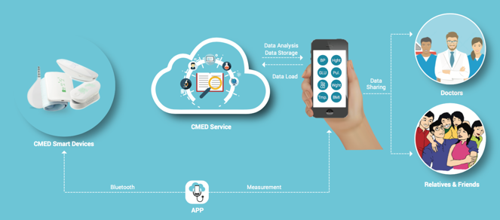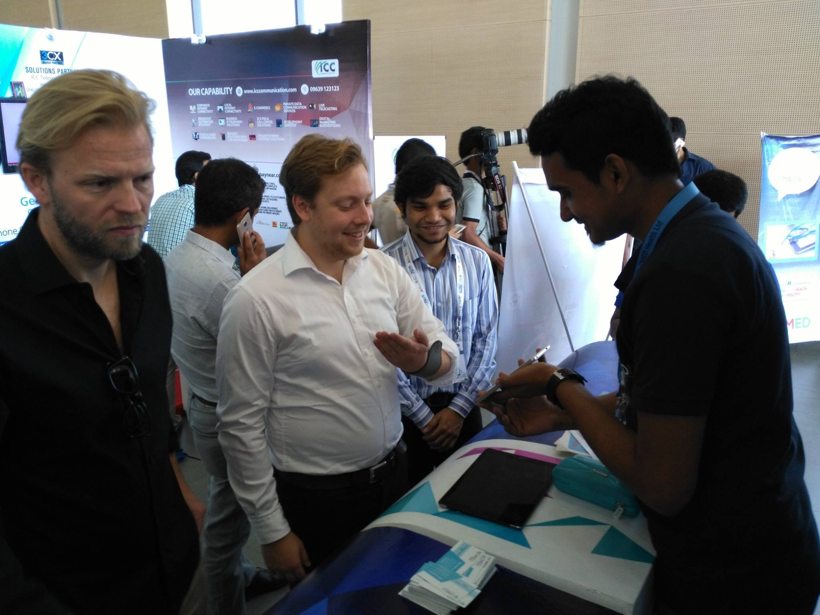
Each year, millions of people die from preventable diseases around the world. In 2000, in the USA alone, where the level of awareness about diseases exists in a substantial level compared to Bangladesh, half of all deaths recorded were from preventable diseases. Given the level of education and awareness, the statistics which is unavailable, it should be worse in Bangladesh.
CMED, a cloud-based preventive health care startup, aims to tackle this problem with its low cost affordable preventative health care technology.
The story of CMED is interesting. Dr. Khondaker Abdullah Al Mamun, a Computer Science and Engineering graduate and BioMedical Engineering Scientist, was inspired, by his mother’s chronic diabetic illness, to design a system that could enable the relatives of the patients or the patient himself/herself to monitor the major vitals of a human organism. The startup is now offering its cloud-based smart health monitoring system, consists of a portable smart monitoring device and a Smartphone Application, to B2B users in Dhaka while also anyone can avail the service by buying the kit from CMED.
We recently sat down with Dr. Mamun to know more about CMED, how the startup is doing after graduating from GP Accelerator, its commercial launch, current state and challenges and the future plans.
Future Startup
Briefly tell us about yourself. And how did CMED come to exist?
Dr. Khondaker Abdullah Al Mamun
I did both my B.Sc. and M.Sc. in Computer Science and Engineering (CSE) from Ahsanullah University of Science and Technology (AUST) and Bangladesh University of Engineering and Technology (BUET) respectively in 2002 and 2007. After my bachelor's degree, I joined as a faculty member in CSE department of AUST. I worked there from 2002 to 2007. Then, I went to Saudi Arabia as a researcher at King Saud University. From there I went for my Ph.D. in the University of Southampton, the UK in 2008 and it was also a rapid shift from CSE to biomedical engineering.
In 2012, I was yet to finish my Ph.D., I got a job as a postdoctoral research fellow at the University of Toronto in Canada. I joined there in July 2012 in the Institute of Biomaterials and Biomedical Engineering (IBBME) of University of Toronto, with a joint appointment at Holland Bloorview Kids Rehabilitation Hospital (Canada’s largest children’s rehabilitation teaching hospital), Toronto, Canada.
I did quite a bit of work on healthcare and disabilities at the University of Toronto. I along with other colleagues were involved in the development of a medical device which was bought by Nestle health Science and is currently under clinical trial for US Food and Drug Administration (FDA) approval. It was a dysphagia (swallow health) monitoring device using iPad.
People who are stroke patients are very prone to pneumonia, our device has a sensor on it which can identify the danger ahead of time and notify the user via mobile devices. I have also worked on the subject of lifestyle management of diabetes patients.
I always had a plan to return to Bangladesh and do something for my country. Therefore, in 2014, I left my job from University of Toronto and returned to Bangladesh and joined at United International University (UIU). Immediately after joining, I set up a research lab named Advanced Intelligent Multi-disciplinary Systems (AIMS) lab.
In the lab, we started working on a couple of areas, includes healthcare, disabilities, and education. During that time I found out that Bangladesh has a phenomenal mobile phone penetration. This got me thinking. I thought to myself why not I utilize this demography to develop a mobile application to help people with healthcare and disabilities. I have worked in this field before, why not I give it a try again?
Moreover, I have my personal experience of suffering. When I was in the UK for my Ph.D., my wife also started her Ph.D. in computer science at the University of Southampton, the UK in 2009. Our first baby born in 2010, as both of us were students, to look after our baby, both my mother and my mother-in-law took turns and stayed in the UK with us for 6 months each time.
My mother had a serious ailment. She lost one of her kidneys. Also, she is a cancer survivor and a high diabetic patient. So, when she was visiting, we took care of her and managed to keep her diabetes under control and a low amount of medication was being needed.
But, as soon as she returned to Bangladesh, her diabetes would again deteriorate. We realized that it was not being properly managed back home largely because they could not track and take proper care of her. That experience also inspired me to develop mobile devices and applications to provide people with health care services.

We started with designing a glucose device that can connect with a mobile application. We later designed a few other devices including a blood oxygen saturation measurement device, temperature scale etc. The development soon became tough for me to manage all by myself as Bangladesh lacks resources of device manufacturing. So, I began searching for partners.
Meanwhile, I also started to study how rural people and people-in-general receive health care service in Bangladesh. That’s when I decided to start CMED, which is a cloud-based health monitoring system focused mainly on the people in rural areas.
The platform works something like this: there is a CMED box. Our community health workers will take this boxes to households and register everyone's physical conditions. The collected data of the physical condition will be sent to a central database where they will be analyzed. Based upon that analysis, our experts will provide their suggestions. This suggestion will then be passed on to the respective individuals by the health workers that they can access through mobile apps. The research paper on CMED was published in a recognized international journal on December 2015. This was the basic plan initially.
In the beginning of 2016, I was invited to give a presentation at BIRDEM Hospital on mobile health. So, I gave a presentation on my diabetes-related mobile application and CMED. There were several doctors present in the meeting, they all admired and provided valuable feedback. They asked why I was particularly designing this service for the rural regions only whereas this is a necessity in the urban areas as well. It got me thinking and, as a result, we changed our model from rural health monitoring to regular health monitoring for all.
In April, we began to plan our business model. At that time, ICT Ministry was offering an innovation fund and we applied for developing Virtual Health Service project which combines all our health research products and services. Fortunately, we won the program. And now CMED is one of the key components of that project. This is why we acknowledge ICT Ministry's role in all our communication material.
Immediately after that, GP Accelerator announced its call for applications for its second batch. Fortune favored us again and we were chosen to be in the program. It was very helpful for us. We learned a lot of things and have worked extensively on the business model. Our business model was previously B2C, but now we are leaned mostly toward a B2B model.

Future Startup
How does CMED, as a product, work?
Dr. Khondaker Abdullah Al Mamun
Quite simple. We have medical sensors integrated into the application we make, which can record and monitor the vital signs of a human body. There are in total 6 medical sensors that monitor 8 vitals: blood pressure, pulse, oxygen saturation, glucose, temperature, weight, height, and BMI. It is very important to monitor these factors, especially in Bangladesh because non-communicable diseases such as diabetes and hypertensions are rising rapidly.
A recent statistic indicates that a staggering 61% of the total healthcare cost including government and out-of-pocket spending is spent on non-communicable diseases. But most of them are preventable, which makes it more shocking. This is what made us concentrate on managing and providing preventive health care service to reduce health risk and healthcare cost.
All of our devices are automatically connected to a mobile application which keeps the record of patient's’ health trends, this is to some extent an application of IoT. This record book will be a great help to doctors to treat patients with a more evidence-based decision.
Now we are developing CMED Health Kit which includes smart devices and one tablet phone for providing health monitoring service.
Currently, we have more than 5,000 users and 5 companies who are using CMED service.
To provide our service to a party, say, a company, we first sign a contract with them affirming the package they want based on the number of their employees. For a company with more than 500 employees, we charge $1-2/person for one month. Our package comes with 10 services: 8 vital checkups, health record, and on-demand doctor consultation as well as blood grouping.
Future Startup
How do you ensure that your data will be accepted by the doctors and also that data of your users are secured?
Dr. Khondaker Abdullah Al Mamun
All our devices are medical grade and internationally certified. Therefore no concern of authenticity of the measured data. We also have manual to guide our user to use our devices and application. We are also very concerned about data security, of course. We have a standard algorithm and customized security system to ensure that our data is safe.
Future Startup
How do you manufacture your devices? Do you have IP protection for your technology?
Dr. Khondaker Abdullah Al Mamun
We have manufacturing partners in abroad who do the manufacturing for us. And we have filed the patent application.
Future Startup
What are the challenges for CMED now?
Dr. Khondaker Abdullah Al Mamun
For now, the challenges is scaling our services while also ensuring the best quality customer service.
Future Startup
You already have a few thousand users. How is the response so far?
Dr. Khondaker Abdullah Al Mamun
The response so far is very good. Most of our users are happy with our service. Initially, many users reacted rather negatively but as they started to take our service regularly they gradually became a regular user.
Our service has yielded some surprising observations. For example, based upon our examination of 500 people of garment workers, we have found out that at least 10 of them were unaware of the fact that they were highly diabetic.
That said, we have just started operation. we have to wait to see how the future unfolds.

Future Startup
Who are your target customers? Are you selling your CMED Kit or devices to general users?
Dr. Khondaker Abdullah Al Mamun
Currently, we are targeting three kinds of B2B clients, whom we think need this service that includes corporate offices, manufacturing factories, and educational institute, where awareness of occupational health is minimal.
We also plan to sell devices separately to individuals. Currently, we are taking pre-orders.
Future Startup
What are your plans for 2017?
Dr. Khondaker Abdullah Al Mamun
By the end of 2017, we expect to have more than 100,000 regular users. The growing demand for our service agrees with our plan.
We also have plans to introduce a couple of new services. We currently have a mobile application for android. Soon we will release our iOS version.
We are in the process of raising investment. We are in talk with a couple of local and international investors. We hope to close the deal soon.
